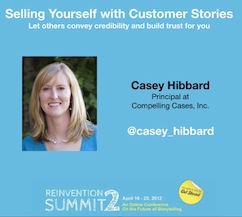Reinvention Summit 2 is history, but I’m continuing to recap, synthesize, and expand on its 20 excellent sessions.
A post by Lou Hoffman in his blog, Storytelling Techniques for Effective  Business Communications, made an interesting juxtaposition with the Reinvention Summit 2 session presented by Casey Hibbard. (Interestingly, both Lou and and Casey have been part of my Q&A series.)
Business Communications, made an interesting juxtaposition with the Reinvention Summit 2 session presented by Casey Hibbard. (Interestingly, both Lou and and Casey have been part of my Q&A series.)
Lou contends that a typical customer case study follows a standard formula:
- Here’s the problem
- It was a horrible
- Fortunately, ACME Technology came to the rescue
- Snapshot of the product(s) from ACME
- It was easy to install
- Here’s how we did it
- Quantify the benefits
- We’re thrilled
He was attracted to this video, describing customer Suncorp’s experience with vendor Net App, for its fresh approach. He liked the emotional dimension of describing how Net App enabled Suncorp’s IT department to become a “launchpad” (as opposed to more typical corporate-speak jargon). He liked that Net App was barely mentioned in the piece, and the focus stayed on Suncorp. He admired the production values — “fresh camera angles,” “energetic pace,” and simple audio. He liked that the video is just 101 seconds. Overall, Lou was impressed by the emotional impact of the story told, including the imagery of IT professionals flying kites.
 Casey Hibbard would call the Suncorps/Net App vignette a “success story” rather than “case study.” In her book, Stories that Sell, she makes this distinction:
Casey Hibbard would call the Suncorps/Net App vignette a “success story” rather than “case study.” In her book, Stories that Sell, she makes this distinction:
… a success story is an overview of the customer’s experience with your products, services, or company. Case studies, usually two or more pages, go into more specifics about one or more customers, providing greater detail about certain aspects of a customer’s experience.
She notes, however, that “most organizations call their customer stories case studies, success stories, customer profiles, or a number of other names, without regard to these specific definitions.”
Would Casey say the piece fits into her six characteristics for a compelling customer story (graphic at top, right) — right customer, right time, right questions, right focus, right results, and right quotes? Probably since the story is, in fact, as Lou notes, compelling.
As for its structure compared to what Lou presents as the standard formula, Casey observes that googling “customer success story” or “customer case study” often reveals stories with “a traditional flow with classic subheads: ‘Company’ or ‘Background,’ ‘Challenge,’ ‘Solution,’ and ‘Results.'” (Note that she seems to be talking primarily about stories in print rather than video.) The standard formats, as Lou points out, just don’t draw people in because they’re so overdone. Casey writes:
… because it’s so common, this format may not be as engaging for readers as other approaches, especially for audiences who frequently read customer stories as they evaluate products or services. Just like a direct mail piece or a Web site, a customer story should be designed in a way that stands apart and draws in readers.
Instead, Casey offers other formats, such as a journalistic feature story, a Q&A, a story-within-a-story, the expected-results story, and the customer-focused story (which seems to fit the Suncorp/Net App story).
The lesson here — from both Lou and Casey — is that you can go far beyond standard customer-story/case-study structures and formats to create an emotional connection with your audience and draw people to your message.
More from and about Casey:

